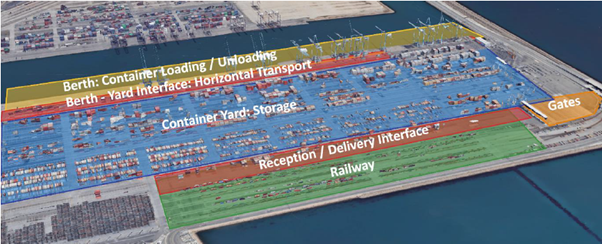Current Challenge
iTerminals 4.0 - Project M8 (Activity 2)
Project M8 (Activity 2) Conclusions
iTerminal ADDRESSES CURRENT CHALLENGES

iTerminals 4.0 OVERVIEW
Technology is continually evolving to better its aid in business, health, and overall standard of living. However, the pace of technological change is too great for those who are already behind even to catch up. As most shipping and terminal stakeholders operate independently, they develop their standard of procedures. Consequently, they recluse themselves from globalizing, which pushes the current knowledge gap even wider and becomes more challenging to achieve supply chain cohesion. Taking the initiative to abate the inconsistencies, iTerminals 4.0 established to determine universal standards for port-container terminals and facilitate future digitization and interoperability.
iTerminals 4.0 is a committee of various world-class industry leaders collectively working together to boost digitalization and help the Port Industry participate in the 4th Industrial Revolution. Pilot tests are conducted to evaluate innovations – whether that is new product software or equipment and are measured against their objectives to determine its value and fit for purpose.
CURRENT CHALLENGE
Technologies have transformed the way operations perform and are still evolving to accommodate different industry needs better. With each upgrade or new rollout surprising the last, business goals are now prioritizing operational efficiency and sustainability, which rarely exist without some form of digitalization. While many tech innovations disrupt and boost growth for businesses, the shipping and terminal industry have not been able to benefit from digitalization fully.
The lag in technological knowledge combined with lack of standardization has denied proactiveness and efficiency in processes, equipment, and actions in events. Because they develop business frameworks independently, naturally, their business requirements catering to these objectives vary from terminal to terminal. However, given the strain of the current global supply chain, iTerminals 4.0 recognizes taking a united front regarding standardization and digitalization will offer better opportunity and prospects.
The biggest challenge arises from transmitting real-world complexities into the virtual, and it mainly stems from the lack of coordination in standardizing practices. The separate development in the initial decades of terminal operating solutions and containerization varied across several regions worldwide. As a result, discrepancies in words, descriptions, sentences, and protocols, attribute to the misconfiguration of project implementations not realizing the full benefit of new technologies.
Language disparity even for the same unique word “move,” can refer to certain parts of the process while being used in all areas of terminal operations, ranging from being handled, such as at the Berth, STS, Yard, Gate, Port, TEU, Reefer, etc. Similarly, the term “cycle” in port equipment can render different meanings as it differs from brand and equipment, like for STS, ASCs, RMGs, straddle carriers, RSTS, AGVs, terminal trucks, etc.
Therefore, efforts to institute a standard framework of operating is required to achieve operational efficiency and business sustainability. Taking the initiative to mitigate these inconsistencies, iTerminals 4.0 investigates a wide range of technological innovations to determine a set of standards best fit for the industry.
iTerminals 4.0 PROJECT M8 (ACTIVITY 2)

The project conducted in Valencia Port lasted nine months (1 March 2019 – 31 December 2019) in efforts to define a coherent catalogue of operational definitions. An agreed standard for interpreting operations, concepts and its semantics are necessary to characterize the container handling processes taking place in port-container terminals. Objectives to achieve port and terminal standardization stems from a determination to achieve consistent data communication exchange among port-container equipment systems, which will inherently facilitate complete interoperability.
Standards broadly accepted by the industry serves as a foundation shaping the business framework of enabling lower implementation costs. The activity also intends to facilitate the successful deployment of new technologies by deeming a container terminal as a modular system drilled down to an array of sub-modules. The ecosystem of sub-modules comprises of operational processes which interlink via interfaces, as depicted in the visual representation below

Multidisciplinary working groups involving port container operators, port equipment manufacturers, and service providers/vendors collectively work together to establish the framework governing this activity. As a result, there are five working groups which correspond to the main container terminal processes:
- Vessel – Berth Interface
- Land access – yard terminal interface, including rail and road access.
- Berth – Yard interface considering Rubber Tired Gantry Crane operations as primary equipment.
- Berth – Yard interface considering Straddle Carrier (SC) operations as leading equipment.
- Berth – Yard interface considering automated guided vehicles (AGVs) operations as main equipment.
The five working groups follow an agreed methodology, so that examined under the same criteria, definitions achieve standardization for all relevant definitions in each process of their respective working group.
Following this approach of dividing terminal operations into different modules enables a better understanding and analysis of associated processes inherent within a container terminal. The outcome of Activity 2 generated the first version of an operational definitions catalogue with an existing database containing 100 definitions, which will continually update throughout the project life.
Definitions already available help define and standardize core operational processes which impact logistics and activity within port container terminals. Requirements can then form to facilitate project pilots. Working groups can access the definitions catalogue via Confluence; an online collaborative platform offering tools and templates for definitions which translate into standard telemetry semantics structure.
Determining conceptual definitions of the project pilots is another objective of Activity 2, drawing focus to four improvement areas of container handling activity:
- Operations/Performance
- Operational Safety
- Energy Efficient
- Maintenance
The pre-engineering study established during reporting report correlates to the pilot’s conceptual definitions.
PROJECT M8 (ACTIVITY 2) CONCLUSIONS

The first concept definitions developed by iTerminals 4.0 in Activity 2 project pilots consist of:
- Operations/Performance Conceptual Pilots
- Big Data Analysis Tool and KPIs Control Panel can obtain, analyze, and show real-time data coming from the various port equipment and their operations.
- Develop algorithms which recognize and identify operational bottlenecks derived from inefficiencies in the container handling process.
- Enhance the yard planning system by integrating the abovementioned tool in the existing control management system of the terminals.
- Integration of data procured from the Internet of Things (IoT) devices as well as (other) terminal equipment data into a cloud Terminal Operating System (TOS) enhance planning and forecasting. The data also feeds an AI module to generate predictive analytics results for the near-time terminal operations.
- Operational Safety Conceptual Pilots
- Heightened situational awareness for port personnel and drivers for the duration of their interaction with Container Handling Equipment (CHE).
- Creation of telemetry systems connected to safety concepts such as safety checklists.
- Dynamic tire pressure, oil, and brake reporting and monitoring.
- Energy Efficiency Conceptual Pilot
- Test energy efficiency monitoring by extracting and transmitting fuel consumption information in real-time to assess energy performance and carbon footprint produced at the terminal.
- Maintenance Conceptual Pilots
- Digitization of the maintenance systems of container terminals which also involve maintenance work orders and breakdown notifications.
- Creation of preventive maintenance pilots in electrical STS cranes.
iTerminals will drive the digitalization of port operations and adoptions of industry 4.0 technologies within the container handling sector, embodying “Container Terminal 4.0.” With Activity 2 achieving operational standardization and reinforcing a unified stance on information exchange, will inherently shape iTerminals 4.0 pilots. The catalogue will institute clarity within methods and rules for analyzing operational efficiency, energy, safety, and maintenance performance conditions of container handling operations. It is critical to establish a standard definition or language to prevent resource and time exhaust derived from implementing new technologies.
For more information about iTerminals 4.0, please click here to visit their website.
